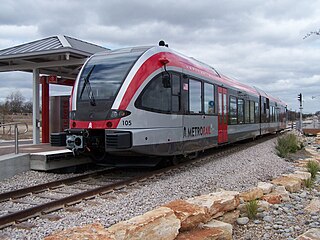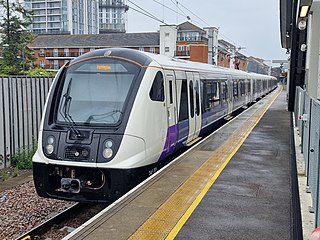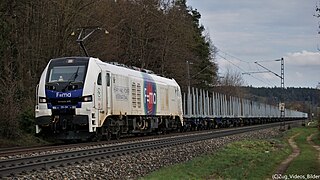
A diesel multiple unit or DMU is a multiple-unit train powered by on-board diesel engines. A DMU requires no separate locomotive, as the engines are incorporated into one or more of the carriages. Diesel-powered single-unit railcars are also generally classed as DMUs. Diesel-powered units may be further classified by their transmission type: diesel–mechanical DMMU, diesel–hydraulic DHMU, or diesel–electric DEMU.

A railcar is a self-propelled railway vehicle designed to transport passengers. The term "railcar" is usually used in reference to a train consisting of a single coach, with a driver's cab at one or both ends. Some railway companies, such as the Great Western, termed such vehicles "railmotors".

The Siemens Desiro is a family of diesel or electric multiple unit passenger trains developed by Siemens Mobility, a division of the German Siemens AG conglomerate. The main variants are the Desiro Classic, Desiro ML, Desiro UK and the later Desiro City, Desiro HC and Desiro RUS. The trains are mostly used for commuter and regional services, and their rapid acceleration makes them suitable for services with short distances between stations. The design is flexible, and has become common in many European countries.

The Broadmoor Manitou and Pikes Peak Cog Railway is a cog railway that climbs one of the most iconic mountains in the United States, Pikes Peak in Colorado. The base station is in Manitou Springs, near Colorado Springs.

A streamliner is a vehicle incorporating streamlining in a shape providing reduced air resistance. The term is applied to high-speed railway trainsets of the 1930s to 1950s, and to their successor "bullet trains". Less commonly, the term is applied to fully faired upright and recumbent bicycles. As part of the Streamline Moderne trend, the term was applied to passenger cars, trucks, and other types of light-, medium-, or heavy-duty vehicles, but now vehicle streamlining is so prevalent that it is not an outstanding characteristic. In land speed racing, it is a term applied to the long, slender, custom built, high-speed vehicles with enclosed wheels.

The Alstom Coradia LINT is an articulated railcar of the Alstom Coradia family manufactured by Alstom since 1999, offered in diesel and hydrogen fuel models. The acronym LINT is short for the German "leichter innovativer Nahverkehrstriebwagen". It was designed by Linke-Hofmann-Busch and has been distributed as part of Alstom's Coradia family.

Stadler Rail AG is a Swiss manufacturer of railway rolling stock, with an original emphasis on regional train multiple units and trams, but moving also into underground, high speed, intercity and sleeper trains. It is also producing niche products, such as being one of the last European manufacturers of rack railway rolling stock. Stadler Rail is headquartered at its place of origin in Bussnang, Switzerland. Stadler Rail employed 13,900 employees by 2023.

The Stadler GTW is an articulated railcar for local transport made by Stadler Rail of Switzerland. GTW stands for Gelenktriebwagen.

The Alstom Coradia is a family of diesel multiple units, electric multiple units, and unpowered rail cars for intercity and regional service manufactured by Alstom, with variants operating in Europe, North America, and Africa.

Stadler FLIRT is a passenger multiple unit trainset made by Stadler Rail of Switzerland. The baseline design of FLIRT is an electric multiple unit articulated trainset that can come in units of two to twelve cars with two to six motorized axles. The maximum speed is 200 km/h (125 mph). Standard floor height is 57 cm, but 78 cm high floors are also available for platform heights of 76 cm.

A battery electric multiple unit (BEMU), battery electric railcar or accumulator railcar is an electrically driven multiple unit or railcar whose energy is derived from rechargeable batteries driving the traction motors.

The Alstom Aventra is a family of electric multiple unit (EMU) passenger trains produced at Derby Litchurch Lane Works in the United Kingdom, originally by Bombardier Transportation and later by Alstom, as a successor to the Bombardier Electrostar. A large proportion of its design is based on the Electrostar, adding new technologies and achieving compliance with more stringent requirements and operator demands.

Diesel multiple units and railcars are trains, usually with passenger accommodation, that do not require a locomotive. Railcars can be single cars, while in multiple units cars are marshalled together with a driving position either end. As of December 2010, 23 percent of the rail passenger cars used on Network Rail are part of a diesel multiple unit.

The Stadler EuroDual is a series of dual power, electro-diesel locomotive by Stadler Rail Valencia. Unlike traditional dual mode locomotives, fitted with relatively low-powered diesel engines for 'last mile' movements only, vehicles are typically furnished with power units more comparable to that of mainline diesel locomotives.

The British Rail Class 802 is a type of high-speed bi-mode multiple-unit passenger train designed and produced by the Japanese manufacturer Hitachi Rail. It has been operated by Great Western Railway, TransPennine Express, and Hull Trains; each of these train operating companies has given its own units a unique brand: Great Western Railway's units are branded Intercity Express Trains (IETs), TransPennine Express units are branded Nova 1s and Hull Trains' units are branded Paragons.

The CAF Civity is a family of regional passenger trains which is manufactured by Spanish rolling stock manufacturer Construcciones y Auxiliar de Ferrocarriles. Available as both diesel, electric and battery-electric multiple unit, the Civity was first launched in 2010 and received its first order two years later.

The Stadler Citylink is a series of tram-trains manufactured by Stadler Rail at its Valencia factory since 2011. The design was introduced by Vossloh España before their takeover by Stadler Rail in 2015. They are currently used in Germany, Hungary, Mexico, Spain and the United Kingdom, with more on order in Austria.

An electro-diesel multiple unit (EDMU) or bi-mode multiple unit (BMU) is a form of a multiple unit train that can be powered either by electric power picked up from the overhead lines or third rail or by using an onboard diesel engine, driving an electric generator, which produces alternating current (AC) or direct current (DC) electric power.

The British Rail Class 769 Flex is a class of bi-mode multiple unit (BMU) converted by Brush Traction, and running in service with Northern Trains. The train is a conversion of the existing Class 319 electric multiple unit (EMU), a conventional unit type which had become surplus to requirements during the 2010s.




















